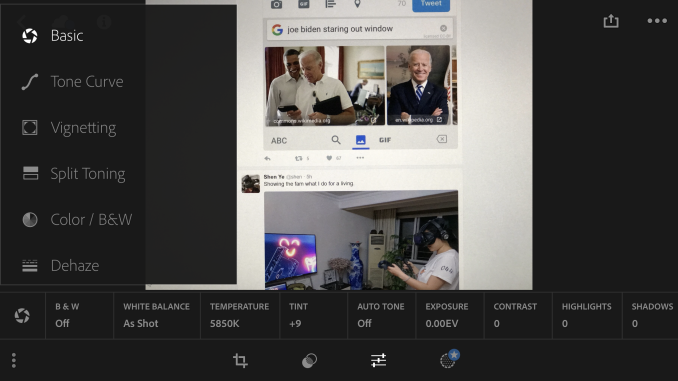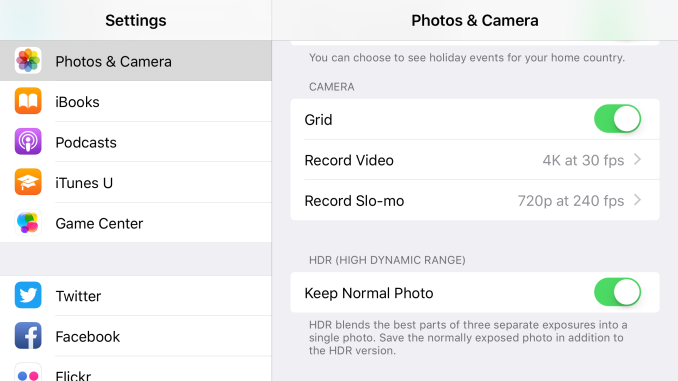The iPhone 7 and iPhone 7 Plus Review: Iterating on a Flagship
by Joshua Ho & Brandon Chester on October 10, 2016 8:00 AM EST- Posted in
- Smartphones
- Apple
- Mobile
- iOS
- iOS 10
- iPhone 7
- iPhone 7 Plus
Camera Architecture
Before we get into the results of the camera output it's always helpful to actually examine the basic characteristics and hardware that make up the camera as a number of characteristics can be predicted or understood by looking at the basic hardware. The CIS technology used can have significant impacts on noise, active area, and a number of other features including slow motion video capture. However, to say that the CIS is the only area worth examination ignores the whole chain of hardware and software needed to make a great camera. With that said we can start our look at the camera with the table below which summarizes a number of high level details for the camera.
| Apple iPhone Cameras | ||||
| Apple iPhone 6s Apple iPhone 6s Plus |
Apple iPhone 7 Apple iPhone 7 Plus |
|||
| Front Camera | 5.0MP | 7MP | ||
| Front Camera - Sensor | Sony ? (1.12 µm, 1/5") |
Sony Exmor RS (1.0 µm, 1/?") |
||
| Front Camera - Focal Length | 2.65mm (31mm eff) | 2.87mm (32mm eff) | ||
| Front Camera - Max Aperture | F/2.2 | F/2.2 | ||
| Rear Camera | 12MP | 12MP | ||
| Rear Camera - Sensor | Sony Exmor RS (1.22 µm, 1/3") |
Sony Exmor RS (1.22 µm, 1/3") |
||
| Rear Camera - Focal Length | 4.15mm (29mm eff) | 4mm (28mm eff) 8mm (56mm eff) Secondary |
||
| Rear Camera - Max Aperture | F/2.2 | F/1.8 F/2.8 Secondary |
||
Looking at the camera of the iPhone 7 in some ways the cadence has changed up a bit. While the iPhone 5s to iPhone 6 transition saw the use of almost identical camera sensor and optics, the iPhone 7 actually changes things up relative to the camera that we saw in the iPhone 6s, likely because the difference between the iPhone 6 and 6s camera was fairly mild in still photos. The iPhone 7 still appears to use a similar sensor on the rear, but with a new set of optics that incorporates a wider aperture. Apple seems to be fighting against serious z-height limitations, so we’re continuing to see a reduction in focal length as the iPhone 7 is now basically comparable to phones like the One M7 with its 28mm equivalent focal length. It’d be interesting to know transmission efficiency which would allow for proper comparisons between generations but considering how most dSLR lenses don't' list these specs it's not a surprise that we don't see this kind of disclosure.

iPhone 7 Plus's dual camera modules (Image Courtesy iFixit)
What isn’t listed on the spec sheet is that the iPhone 7 now has OIS, which is going to be a serious step up in terms of performance for anyone upgrading from the iPhone 6 or 6s. While Apple has some proprietary EIS that allows for really impressive performance despite the lack of OIS, a physical mechanism to compensate for hand shake is going to make for a more effective system in the first place, as it fixes the problem before the photons are captured. Apple continues to use advanced software to enable long exposure without visible blur or hand shake so the addition of OIS shouldn’t have any noticeable drawbacks other than increased shot latency in low light.
Of course, the iPhone 6s Plus already had OIS, so for the iPhone 7 Plus there is a new secondary camera with a focal length that is twice as long as the primary camera. However, the aperture is smaller, which means that in low light the system is going to automatically fall back to the primary camera which is still better in low light as far as I can tell, especially because the second camera lacks OIS. However, in bright daytime conditions the second camera’s longer focal length allows for better portraits and better detail in general. This helps to compensate for the iPhone’s sensor size and z-height limitations, but can only really help in daytime conditions.
Interestingly enough, Apple is actually one of the first OEMs to my knowledge to adopt a 1 micron pixel pitch for a camera sensor, but this is being done for the front-facing camera. I’m kind of curious to know what led to this decision as the optics are probably not going to be able to resolve such a small pixel size. We generally don’t review front-facing cameras but for the people that care about this sort of thing I suspect that the FFC is mostly a sidegrade in the sense that it’s probably going to be used to enable higher resolution video capture rather than higher quality still photos.
Camera UX
As far as the camera application goes, there’s really nothing new this generation. If you’ve taken pictures with a relatively new iPhone, you’re going to be right at home with the iPhone 7’s camera UI. For those that haven’t used a relatively new iPhone before we can do a quick review to discuss what is and isn’t present. At a high level, the UI is split up into a few logical sections, with mode-specific options in their own section. Modal selection is on the opposite side, with text that fairly clearly delineates the purpose of each mode. Below the modal selection, general options are presented for things like changing between front and rear cameras as well as the shutter button and camera roll.
It's hard to really say much about the iPhone camera UI at this point because it’s been polished to the point that there’s really no obvious criticisms to make about it. Apple may have made the mistake of shipping a 16:9 preview for a 4:3 camera before, but it’s been years since glaring issues like that have come up. Tapping to focus allows for either locking focus and exposure or biasing the exposure, which is going to provide coverage for 95% of still image cases. Of course, if you want more fine adjustment the default camera app is going to be inadequate, but there are plenty of good manual camera applications on the market like ProCam, ProShot, and Manual Camera.
It’s worth mentioning that while Apple was far from first to implement RAW capture on smartphones, their implementation is differentiated by a real end to end solution. Something like the HTC 10 really needs Lightroom to bring out the best in its RAW captures, although Snapseed is still reasonably useful in a pinch. Apple is leveraging their ecosystem which allows for things like fully featured Adobe Lightroom for RAW processing. I thought for a very long time that processing RAW was infeasible in the context of a smartphone TDP without fixed-function hardware, so it’s incredibly impressive to see Lightroom working smoothly when processing RAW images.
While most of the camera UX is designed well, one noticeable issue here is that the camera settings are integrated into the settings application rather than the camera application itself. If you’re used to how iOS works this makes sense, but things like resolution settings for video are placed in this menu rather than integrated into the camera application which makes switching between these settings relatively painful if you’re used to something like the HTC 10’s camera UI which places resolution settings in a slide-out drawer. This isn't a huge issue but it's definitely something I noticed due to the need to rapidly switch between resolution settings for video testing. Your mileage may vary here if you don't particularly care for such issues. Overall though, the camera UX has few friction points.













377 Comments
View All Comments
tuxRoller - Thursday, October 13, 2016 - link
Oh yes, AnTuTu. What does that do again? How does it do it?Geekbench is SLIGHTLY better as it explains, at a fairly high level, how each test is performed. It even lets you know that they are preference apple by using llvm everywhere.
None of these are worth respecting reporting on, however, unless the benchmarks are open source.
Ranger1065 - Wednesday, October 12, 2016 - link
The old Anandtech...maybe :)Dribble - Monday, October 10, 2016 - link
If you like your wireless headphones that's great, but don't try to sell me that ONLY having them is somehow fine. It's not like you couldn't use wireless for iphone 6 and now suddenly you can. Sometimes wired is better - e.g. phone in the car, you are charging phone and plugging into the jack to play music off it. You don't want to have to take some silly adaptor dongle everywhere with you in case you need wired (that's a bad user experience).It would also have been more honest to say why they removed it - it's not for some mythical extra space to add other stuff like you suggested, its 100% to make more $$$. Irrespective of who designs or makes it anything that plugs into apples proprietary jack has to pay apple money because they own the copyright. They don't own any copyright on the 3.5mm jack. Hence they removed the jack to force devices to use apples jack and hence pay them more money (something we the consumer end up paying for).
solipsism - Monday, October 10, 2016 - link
1) Cars with BT have been on the market for over a decade, it comes with inexpensive automobiles, and those buying a new iPhone 7 aren't likely to be driving a 1984 Toyota Tercel.2) If you're really against BT, and this is to be used while in the car, then why are carrying around this adapter? Wouldn't you just leave it in the car, which is now a single plug into the device, instead of two. If you claim that you wouldn't keep the adapter in the car, are you also saying that you're moving your USB and analog audio cables with you everywhere, too? If so, then what does it matter?
3) You don't even have to look at a teardown of the iPhone to see that internal volume makes a difference to what you can include inside a device. Physics still exit, right? Just look at the back of the iPhone to see that the camera is moved down. Then look at the camera, battery size gain, the better taptic motor, and the barometer, to name a few. If anything, I'd say this move is overdue, and you'll soon see this happen to to the rest of the smartphone market.
4) Apple doesn't own Bluetooth, so how does that argument fit into your 3.5mm jack copyright argument? I assume you know that over 15% of headphone unit sales were wireless last year and that it accounted for over 50% of the market. People typically don't like wires, yet, if you a huge fan of them you have so many options from using a stationary adapter in your car, to not buying a new iPhone, to not buying anything from Apple. Vote with your wallet.
Lolimaster - Monday, October 10, 2016 - link
His is not against bt, he against forced behavior and make the customer believe its the right choice, the future.What hes refering to, is that without the jack change, you had both options without hindering aesthetics and without make the device look stupid and retarded (which will make fashionistas wannabes buy the propietary haedphones), and also make sensible people annoyed by having a "dongle" to use their 3.5 headphones for no other reason but sucking more money out of monkeys/isheeps.
Dribble - Monday, October 10, 2016 - link
1) lots of cars don't have BT even those owned by apple users, it's generally an extra that you have to pay (too much!) for, it's also not as reliable as a solid jack connection.2) I am charging my iphone and playing music I can't plug in both at once. I am in someone else's car and want to share my music.
3) rubbish, the space taken by the jack was tiny, every other phone including all the previous iphones manages fine with a jack.
4) You have to remember to charge wireless headphones, and BT is never as reliable as it's meant to be, it gets confused, takes time to connect. A headphone jack doesn't have those problems, it just works all the time every time. Like I said I am pro having the option to use BT, in fact pretty well every phone on the market and all previous iphones support BT, yet a surprisingly large number of people still use wired - why is that?
grayson_carr - Monday, October 10, 2016 - link
My $19,000 Hyundai Elantra and my wife's similarly priced Honda Civic, both purchased in 2012, both came with bluetooth. And we didn't get the upgraded stereo systems or navigation or anything. If you bought a new car in the past 5 years and it didn't come with bluetooth, you must have really been scraping the bottom of the barrel. Also, I would like to know what car is so barebones?wolfemane - Tuesday, October 11, 2016 - link
Wife and I bought a uses 2002 Nissan Maxima 4 years ago and it had bluetooth... and a tape deck.I don't understand the hate people have towards the removal of the jack. And I wonder how many of those complaining are actual iphone users? I can't remember the last time I even used the headphone jack, been bluetooth for so long.. Personal, and anecdotal, but to the point.
oh and I have an iPhone 6s plus. First iPhone I've ever owned, came from a long line of Android phones (mainly Galaxy's). Gotta say, I dig it a lot more than my old S6.
Klug4Pres - Tuesday, October 11, 2016 - link
People like open standards, and solutions that are effective technologically.Wireless headphones might be "good enough" for many people, but consider that some have invested quite a lot of money in a superior, wired set of headphones. Yes, they can still use them with a dongle, but that is a "friction point" and causes problems with charging while listening to music.
Apple has done this to make money selling Airpods. Remember, it bought a purveyor of crappy headphones, and the company has to get a return on that investment.
This is an unsettling reminder that when buying many consumer electronic devices, we are beholden to companies who will position their products in such a way as to maximize their profits, and not in such a way as to give the best possible value to consumers.
Yes, I know, we can choose to buy or not buy etc. That is what critics are saying - they won't buy, or they will, but reluctantly. Markets do not always provide what people would like to buy. In the smartphone industry, Apple has significant market power, and knows how to milk the consumer (e.g. by drip-feeding features to boost unit replacement, RAM rationing, controling OS updates to break or cripple older phones etc., limiting repairability, sealed batteries, to name a few). On the other hand, a forced replacement cycle is what funds R&D, OS development, customer service, people with jobs at Apple, people with jobs in China, and so forth.
azulon1 - Thursday, October 13, 2016 - link
Look some of your stuff is a little over the line. I think the general argument is that they make their phones only as good as they must to defeat the competition. And I think that they are doing a fine job at it. For instance when you talk about ram rationing? Do they need to add more ram to defeat android headsets?